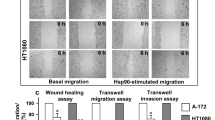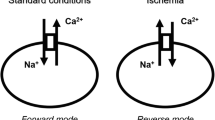Abstract
The monolayer of vascular endothelial cells, which is rich in heparan sulfate chains, is an important target of cadmium cytotoxicity. To investigate the effects of heparan sulfate chains on cadmium cytotoxicity, bovine aortic endothelial cells were cultured in the presence of cadmium, with or without exogenous heparan sulfate. The following results were obtained: (1) Heparan sulfate chains potentiated cadmium cytotoxicity. (2) Such a potentiation did not occur in bovine aortic smooth muscle cells. (3) Heparin chains as well as heparan sulfate chains potentiated cadmium cytotoxicity, while other glycosaminoglycan chains failed to exhibit such an activity. (4) The disaccharide units of heparan sulfate chains did not potentiate cadmium cytotoxicity in the endothelial cells. (5) Heparan sulfate chains did not potentiate mercury and arsenite cytotoxicity. (6) Fibroblast growth factor-2 (FGF-2) also potentiated cadmium cytotoxicity in the endothelial cells. (7) Heparan sulfate chains significantly increased intracellular cadmium accumulation by inducing the expression of metallothionein. Taken together, these results suggest that heparan sulfate chains activate FGF-2, which in turn elevates the expression and/or activity of metal transporter(s) that facilitate cadmium influx from the extracellular space into the cytoplasm.





Similar content being viewed by others
References
Aviezer D, Hecht D, Safran M, Eisinger M, David G, Yayon A (1994a) Perlecan, basal lamina proteoglycan, promotes basic fibroblast growth factor-receptor binding, mitogenesis, and angiogenesis. Cell 79(6):1005–1013
Aviezer D, Levy E, Safran M, Svahn C, Buddecke E, Schmidt A, David G, Vlodavsky I, Yayon A (1994b) Differential structural requirements of heparin and heparan sulfate proteoglycans that promote binding of basic fibroblast growth factor to its receptor. J Biol Chem 269(1):114–121
Bianco P, Fisher LW, Young MF, Termine JD, Robey PG (1990) Expression and localization of the two small proteoglycans biglycan and decorin in developing human skeletal and non-skeletal tissues. J Histochem Cytochem 38(11):1549–1563
Dalton TP, He L, Wang B, Miller ML, Jin L, Stringer KF, Chang X, Baxter CS, Nerbert DD (2005) Identification of mouse SLC39A8 as the transporter responsible for cadmium-induced toxicity in the testis. Proc Natl Acad Sci USA 102(9):3401–3406
Eide DJ (2004) The SLC39 family of metal ion transporters. Pflug Arch 447(5):796–800
Fujishiro H, Okugaki S, Kubota K, Fujiyama T, Miyataka H, Himeno S (2009) The role of ZIP8 down-regulation in cadmium-resistant metallothionein-nul cells. J Appl Toxicol 29(5):367–373
Fujiwara Y, Kaji T (1999) Possible mechanism for lead inhibition of vascular endothelial cell proliferation: a lower response to basic fibroblast growth factor through inhibition of heparan sulfate synthesis. Toxicology 133(2–3):147–157
Fukuda T, Kambe T (2011) Molecular and genetic features of zinc transporters in physiology and pathogenesis. Metallomics 3(7):662–674
Gamse G, Fromme HG, Kresse H (1978) Metaboism of sulfated glycosaminoglycans in cultured endothelial cells and smooth muscle cells from bovine aorta. Biochim Biophys Acta 544(3):514–528
He L, Wang B, Hay EB, Nebert DW (2009) Discovery of ZIP transporters that participate in cadmium damage to testis and kidney. Toxicol Appl Pharmacol 238(3):250–257
Järveläinen HT, Kinsella MG, Wight TN, Sandell LJ (1991) Differential expression of small chondroitin/dermatan sulfate proteoglycans, PG-I/biglycan and PG-II/decorin, by vascular smooth muscle and endothelial cells in culture. J Biol Chem 266(34):23274–23281
Kaji T, Hayashi T, Miezi N, Kaga K, Ejiri N, Sakuragawa N (1991) Gardenia fruit extract does not stimulate the proliferation of cultured vascular smooth muscle cells, A10. Chem Pharm Bull 39(5):1312–1314
Kaji T, Mishima A, Yamamoto C, Sakamoto M, Koizumi F (1992a) Effect of cadmium on the monolayer maintenance of vascular endothelial cells in culture. Toxicology 71(3):267–276
Kaji T, Mishima A, Koyanagi E, Yamamoto C, Sakamoto M, Kozuka H (1992b) Possible mechanism for zinc protection against cadmium cytotoxicity in cultured vascular endothelial cells. Toxicology 76(3):257–270
Kaji T, Mishima A, Yamamoto C, Sakamoto M, Kozuka H (1993) Zinc protection against cadmium-induced destruction of the monolayer of cultured vascular endothelial cells. Toxicol Lett 66(3):247–255
Kaji T, Ohkawara S, Inada M, Yamamoto C, Sakamoto M, Kozuka H (1994a) Cadmium stimulation of glycosaminoglycan synthesis by cultured vascular endothelial cells: comparison of various cell types. Biol Pharm Bull 17(3):454–457
Kaji T, Ohkawara S, Yamamoto C, Sakamoto M, Kozuka H (1994b) Cadmium-induced alteration of glycosaminoglycans with an enhancement of heparin-like activity in cultured vascular endothelial cells. Toxicology 94(1–3):161–171
Kaji T, Suzuki M, Yamamoto C, Imaki Y, Miyajima S, Fujiwara Y, Sakamoto M, Kozuka H (1996) Sensitive response of cultured vascular smooth-muscle cells to cadmium cytotoxicity: comparison with cultured vascular endothelial cells and kidney epithelial LLC-PK1 cells. Toxicol Lett 89(2):131–137
Kambe T, Suzuki T, Nagao M, Yamaguchi-Iwai Y (2006) Sequence similarity and functional relationship among eukaryotic ZIP and CDF transporters. Genomics Proteomics Bioinform 4(1):1–9
Kissane JM, Robins E (1958) The fluorometric measurement of deoxyribonucleic acid in animal tissues with special reference to the central nervous system. J Biol Chem 233:184–188
Kojima T, Leone CW, Marchildon GA, Marcum JA, Rosenberg RD (1992) Isolation and characterization of heparan sulfate proteoglycans produced by cloned rat microvascular endothelial cells. J Biol Chem 267(7):4859–4869
Lichten LA, Cousins RJ (2009) Mammalian zinc transporters: nutritional and physiologic regulation. Annu Rev Nutr 29:153–176
Linhardt RJ (2003) 2003 Claude S. Hudson Award address in carbohydrate chemistry. Heparin: structure and activity. J Med Chem 46(13):2551–2564
Mertens G, Cassiman JJ, Van den Berghe H, Vermylen J, David G (1992) Cell surface heparan sulfate proteoglycans from human vascular endothelial cells. Core protein characterization and antithrombin III binding properties. J Biol Chem 267(28):20435–20443
Mishima A, Yamamoto C, Fujiwara Y, Kaji T (1997) Tolerance to cadmium cytotoxicity is induced by zinc through non-metallothionein mechanisms as well as metallothionein induction in cultured cells. Toxicology 118(2–3):85–92
Nader HB, Dietrich CP, Buonassisi V, Colburn P (1987) Heparin sequences in the heparan sulfate chains of an endothelial cell proteoglycan. Proc Natl Acad Sci USA 84(11):3565–3569
Nolan CV, Shaikh ZA (1986) The vascular endothelium as a target tissue in acute cadmium toxicity. Life Sci 39(16):1403–1409
Ohkawara S, Yamamoto C, Fujiwara Y, Sakamoto M, Kaji T (1997) Cadmium induces the production of high molecular weight heparan sulfate proteoglycan molecules in cultured vascular endothelial cells. Environ Toxicol Pharmacol 3:187–194
Onosaka S, Tanaka K, Doi M, Okahara K (1978) A simplified procedure for determination of metallothionein in animal tissues. Eisei Kagaku 24(3):128–131
Palmiter RD, Huang L (2004) Efflux and compartmentalization of zinc by members of the SLC30 family of solute carriers. Pflug Arch 447(5):744–751
Prozialeck WC, Edwards JR, Woods JM (2006) The vascular endothelium as a target of cadmium toxicity. Life Sci 79(16):1493–1506
Prozialeck WC, Edwards JR, Nebert DW, Woods JM, Barchowsky A, Atchison WD (2008) The vascular system as a target of metal toxicity. Toxicol Sci 102(2):207–218
Ruoslahti E (1988) Structure and biology of proteoglycans. Annu Rev Cell Biol 4:229–255
Saku T, Furthmayr H (1989) Characterization of the major heparan sulfate proteoglycan secreted by bovine aortic endothelial cells in culture. Homology to the large molecular weight molecule of basement membranes. J Biol Chem 264(6):3514–3523
Sato Y, Rifkin DB (1988) Autocrine activities of basic fibroblast growth factor: regulation of endothelial cell movement, plasminogen activator synthesis, and DNA synthesis. J Cell Biol 107(3):1199–1205
Sugahara K, Mikami T, Uyama T, Mizuguchi S, Nomura K, Kitagawa H (2003) Recent advances in the structural biology of chondroitin sulfate and dermatan sulfate. Curr Opin Struct Biol 13(5):612–620
Turnbull JE, Fernig DG, Ke Y, Wilkinson MC, Gallagher JT (1992) Identification of the basic fibroblast growth factor binding sequence in fibroblast heparan sulfate. J Biol Chem 267(15):10337–10341
Wight TN (1985) Proteoglycans in pathological conditions: atherosclerosis. Fed Proc 44(2):381–385
Yamamoto C, Kaji T (2002) Induction of plasminogen activator inhibitor type 1 synthesis by cadmium in human vascular endothelial cells in culture. J Health Sci 48(1):55–61
Yamamoto C, Kaji T, Sakamoto M, Kozuka H (1993) Cadmium stimulation of plasminogen activator inhibitor-1 release from human vascular endothelial cells in culture. Toxicology 83(1–3):215–223
Yamamoto C, Kaji T, Furuya M, Sakamoto M, Kozuka H, Koizumi F (1994) Basic fibroblast growth factor suppresses tissue plasminogen activator release from cultured human umbilical vein endothelial cells but enhances that from cultured human aortic endothelial cells. Thromb Res 73(3–4):255–263
Yamamoto C, Deng X, Fujiwara Y, Kaji T (2005) Proteoglycans predominantly synthesized by human brain microvascular endothelial cells in culture are perlecan and biglycan. J Health Sci 51(5):576–583
Yayon A, Klagsbrun M, Esko JD, Leder P, Ornitz DM (1991) Cell surface, heparin-like molecules are required for binding of basic fibroblast growth factor to its high affinity receptor. Cell 64(4):841–848
Acknowledgments
This work was supported by a Grant-in-Aid for Scientific Research (B) #24390034 from the Japan Society for the Promotion of Science (to T. K.).
Conflict of interest
The authors declare that there are no conflicts of interest.
Author information
Authors and Affiliations
Corresponding author
Rights and permissions
About this article
Cite this article
Fujiwara, Y., Yamamoto, C., Yoshida, E. et al. Heparan sulfate chains potentiate cadmium cytotoxicity in cultured vascular endothelial cells. Arch Toxicol 90, 259–267 (2016). https://doi.org/10.1007/s00204-014-1420-6
Received:
Accepted:
Published:
Issue Date:
DOI: https://doi.org/10.1007/s00204-014-1420-6




